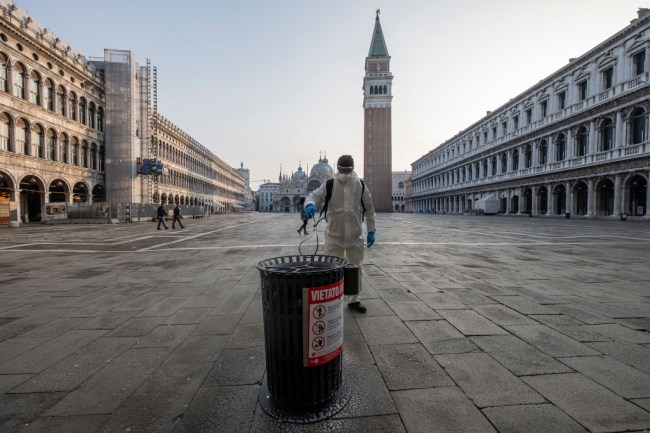
Getty Image / Stefano Mazzola/Awakening / Contributor
With the coronavirus in the headlines recently, you may have heard the term “social distancing.” We’ll answer the question: What is social distancing? Plus, give some historical reference on how it has been employed in the past to stop the spread of a pandemic.
WHAT IS SOCIAL DISTANCING?
Social distancing is the public health measure to reduce the rate of transmission of a communicable disease. When implemented correctly, social distancing can change the trajectory of an infectious outbreak.
The Centers for Disease Control and Prevention (CDC) defines “social distancing” as “remaining out of congregate settings, avoiding mass gatherings, and maintaining distance from others when possible.
The goal of social distancing is not eradicating the disease but rather to flatten the curve, or to decrease the number of people with infection, especially those who will require immediate medical attention so that the health care system is not overwhelmed and hospitals overburdened.
Since COVID-19 is a new disease, humans don’t have any immunity to the disease in their system. That means people can get infected quite easily, especially since the respiratory disease can be transmitted by “just breathing air.” Scientists believe that COVID-19 can live up to three hours in the air.
Your best method of protecting yourself against being infected with the coronavirus is to limit the possible situations where transmission is most likely. Social distancing provides you a set of simple guidelines to minimize the potential for you to catch and spread the COVID-19 as well as other communicable diseases.
The CDC recommends that you always stay approximately six feet away from other people. That means you should avoid places where you’ll be in close proximity to others, such as bars, movie theaters, and sporting events.
Practicing social distancing also means how you greet people. You should immediately stop shaking hands with people or giving high-fives. Even fist bumps and bumping elbows are discouraged since it is still physical contact. Instead, health professionals advise that people wave or bow to others as their greeting.
Steer clear of crowded settings, especially for the elderly and those who have preexisting health conditions such as cancer, heart disease, or diabetes. If someone is coughing, you should avoid getting anywhere near that person.
HAS SOCIAL DISTANCING EVER WORKED BEFORE?
The 1918 influenza pandemic, known as the Spanish flu, infected approximately 500 million people around the world, about 27% of the population at the time. The death toll from the Spanish flu is estimated to be between 17 million and 50 million.
At the height of the pandemic, the city of Philadelphia threw a parade to celebrate the soldiers who served in World War I. A high percentage of military members were sick, but Philadelphia’s publich health director Wilmer Krusen, assured the public that the soldiers were only suffering from the seasonal flu. The Liberty Loan parade on September 28, 1918, was attended by about 200,000, who were crammed together to watch the parade.
Three days after the parade, every bed in Philadelphia’s 31 hospitals was filled with sick and dying patients. By the end of the week, 4,500 people had died from the Spanish flu. By the time Philadelphia had closed the City of Brotherly Love, it was already too late.
Meanwhile, before the first case of Spanish flu was announced in St. Louis, the city closed schools, playgrounds, libraries, courtrooms, churches, and banned public gatherings of 20 or more. The St. Louis health commissioner Dr. Max Starkloff “had local physicians on high alert and wrote an editorial in the St. Louis Post-Dispatch about the importance of avoiding crowds,” according to History.com. The social distancing effort and limiting crowds in St. Louis and other cities cut down the infection rate and flattened the curve.
This graph shows why social distancing is so important.
In 1918 Philadelphia did not, but St. Louis did. Let’s all work to minimize our numbers now. This is temporary. pic.twitter.com/DMGuoJFp8T
— Brad Nitz (@BradNitzWSB) March 12, 2020
Is it actually possible to #FlattenTheCurve?
Yes, St Louis did it before.
In the terrible pandemic of 1918.The chart shows their success:
* Philadelphia downplayed it and held a parade in 1918
* St. Louis canceled gatherings and flattened the curvehttps://t.co/JzwF6JhEWU pic.twitter.com/AGPvM3cJci— Max Roser (@MaxCRoser) March 12, 2020
You can read our article on how to live in a coronavirus world about the do’s and don’ts when it comes to dating, going to the gym, what supplies you need to stock up on, and other advice you can use during the COVID-19 pandemic.
You can find all of the CDC’s data on coronavirus, including prevention and COVID-19 updates, on their website.